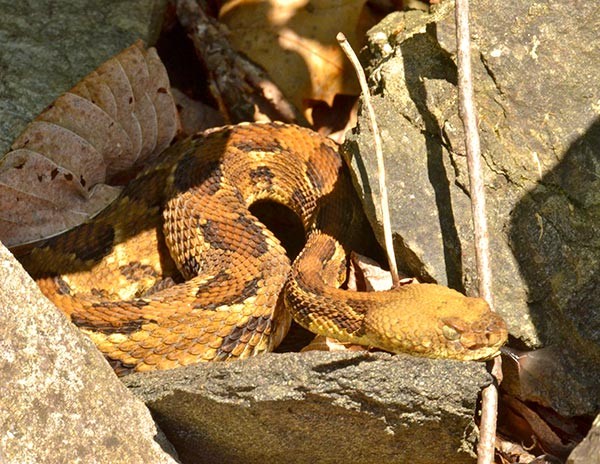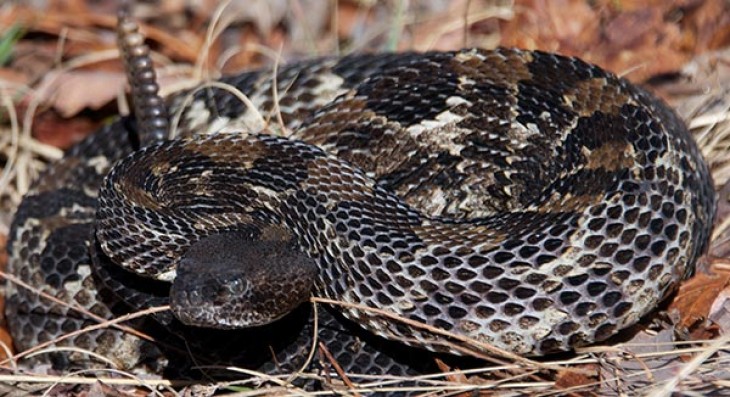Approximately 8,000 years ago, a period of global warming called the Hypsithermal Interval stimulated timber rattlesnakes to move north from the vicinity of Long Island. They followed river corridors – the Delaware, the Hudson, the Connecticut, the Housatonic, the Merrimack – and eventually reached southern Quebec and southwestern Maine. Wherever passageways in bedrock or talus led to frost-free winter retreats, the snakes established colonies. They had an eye for real estate. Indeed, they’re landscape connoisseurs: rising above lakes and rivers and green sprawling valleys like so many solar panels, snake dens face the sun and hold heat on chilly October afternoons. Today, rattlesnakes thrive where the human population is sparse – land that is wide-open, wind-swept, and remote. And like Beethoven, who couldn’t hear the sound of the very music he composed, timber rattlesnakes can’t see the view from where they live. They’re as myopic as Mr. Magoo.
In the Northeast, den-site fidelity is the hallmark of rattlesnake survival. Each fall, they return to their maternal den as directly as a Bicknell’s thrush might return to a particular hillside forest in Hispaniola. When a well-muscled rattlesnake migrates home, it doesn’t undulate in loops and curves as it does when it’s swimming; it flows in a straight line like melting candle wax, belly scales caressing the ground, a thousand little pseudo-feet. Slow...slower...slowest. On a windless afternoon the vague sound of scales brushing leaves gives them away.
Lethargic and predictable and as breathtakingly beautiful as the scenery around them, timber rattlesnakes vary in color from the blackest black to golden yellow. Some are mustard-colored, others are olive or brown or tawny or charcoal gray. Neonates are shades of exfoliated granite. Adults and young have crossbands or chevrons or blotches (or all three) that range in hue from black to gray, chocolate to tan or olive-yellow, and are rimmed (or not) by overexposed yellow or white. Some snakes have a broken, rust-colored, dorsal stripe, a feature that becomes prominent in these animals in the Southeast. Others are patternless black, as dark as an inner tube. Coiled in a bed of October leaves, a timber rattlesnake hides in plain sight unless it rattles, which can be electrifying.
I keep vigil at a den, counting, always counting snakes: a yellow morph, a black morph, a young-of-the- year, a three-year-old, an adult female with a broken ten-segment, untapered rattle – that sort of thing. I note air temperature, rock temperature, snake temperature, cloud cover, and wind speed and direction. Last year, in late August, a few snakes returned to the threshold of the den; more arrived in September. The number peaked in early October, when I tallied more than 80 in one day. I followed two big snakes as they progressed through rock-studded woods to the base of a ledge and then watched them disappear down a crevice. Later that afternoon, when I stood quietly in front of the den’s main portal, a dozen snakes glided by; others poured over the stone rim and then braided themselves together inside the rock foyer before they vanished into the abyss. Two weeks later, I found only three, including a newborn en route to the slumber party.
I don’t spend winters underground below the frost line and I stopped basking decades ago, but sun-warmed rocks feel good to me, particularly when the air is cool and the day short. I go to the slopes to watch rattlesnakes, and I stay until the rocks cool off and autumn’s last whit of heat draws the snakes down below the surface. Like a rain of maple leaves or a flock of migrating geese, the doings of rattlesnakes in October mark a season in transition, the subtlest of autumnal tides.
The snakes at my study site ignore me. I never touch them. I bear witness, my movements ratcheted down to a tic. For the most part, they treat me with indifference. One crossed over my boot. Another moved directly to the rock I stood on; deliberately and delicately, lifted its head above the far edge, flicked its informative tongue half a dozen times, and then proceeded to the den.
Here, in the corrugated Northeast, live a few rattlesnakes born the summer the Beatles released Hey Jude; at least one 40-year-old still bears young. Unfortunately, timber rattlesnakes remain vulnerable to vandals and collectors.
With the aid of a GPS followed by a website announcement, even a well-meaning hiker who stumbles onto a pod of rattlesnakes and then broadcasts exuberance, could be the unwitting vehicle of their demise.
To paraphrase the 1950s television show Dragnet: Ladies and gentlemen, the story you have just read is true. Only the locations have been eliminated to protect the innocent. In this case, the timber rattlesnakes.
America’s Snake: The Rise and Fall of the Timber Rattlesnake, to be published (2015) by University of Chicago Press, explores the intersection between timber rattlesnakes and humanity.




Discussion *